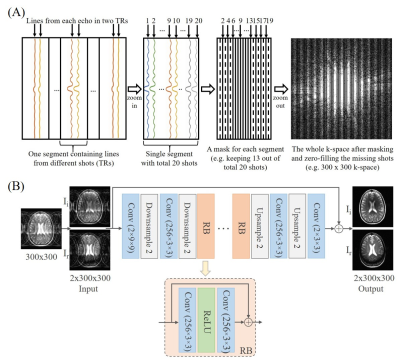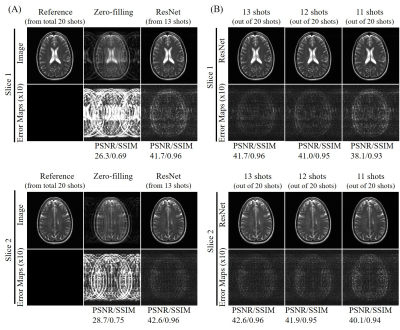Linfang Xiao1,2, Yilong Liu1,2, Yujiao Zhao1,2, Zheyuan Yi1,2,3, Vick Lau1,2, Alex T.L. Leong1,2, and Ed X. Wu1,2
1Laboratory of Biomedical Imaging and Signal Processing, The University of Hong Kong, Hong Kong, China, 2Department of Electrical and Electronic Engineering, The University of Hong Kong, Hong Kong, China, 3Department of Electrical and Electronic Engineering, Southern University of Science and Technology, Shenzhen, China
1Laboratory of Biomedical Imaging and Signal Processing, The University of Hong Kong, Hong Kong, China, 2Department of Electrical and Electronic Engineering, The University of Hong Kong, Hong Kong, China, 3Department of Electrical and Electronic Engineering, Southern University of Science and Technology, Shenzhen, China
We propose a new FSE
acquisition and deep learning reconstruction approach to acquire and
reconstruct single-channel FSE data with significantly reduced number of shots,
which effectively removes aliasing artifacts and recovers high frequency
information without noise amplification.

Figure 1 (A) Illustration of proposed sampling
pattern for incomplete single-channel FSE acquisition with partial shots (TRs).
It acquires partial shots, e.g., by skipping 7 out of total 20 shots at
1/3/5/14/16/18/20 for each segment. (B)
Proposed ResNet for image reconstruction, consisting of 2 convolutional layers
with downsampling, 16 residual blocks (RBs), and 2 convolutional layers with
upsampling. Each RB contains 2 convolutional layers with a rectified linear
unit. The inputs are images directly reconstructed from incomplete k-space data
with missing shots zero-filled.

Figure 2 (A)
Demonstration of the MR reconstruction results by the proposed ResNet from the
incomplete single-channel FSE data (containing 13 out of total 20 shots with
ETL=15). (B) Typical MR reconstruction results with 13/12/11
out of total 20 shots, respectively. Quantitative measures PSNR and SSIM are
also shown. These results demonstrated that the trained ResNet model could
effectively remove the aliasing artifacts and recover the high frequency
information without noticeable blurring at various undersampling levels.